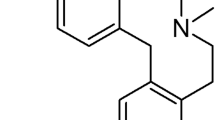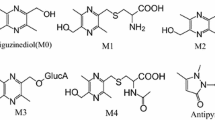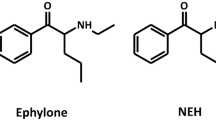Summary
The aim of this study was to investigate by HPLC the in vivo metabolism of 2-[1′-phenyl-3′-(3-chlorophenyl)-2′-propenylyden]hydrazino-3-methyl-4(3H)-quinazolinone as a substrate, and as a model compound in rats. The substrate was dissolved in DMSO/water (1∶4) and administered intraperitoneally at a dose of 100 mg/kg in a volume of approximately 0.1 mL. Blood samples were taken before and 30 min, 1.5, 3, 6, 9, 11, 30 and 48 h after i.p. drug administration. The chromatographic separation of the substrate and its metabolites was performed using a stainless steel Novopak C18 column (150 × 4.6 mm i.d., 5-μm particle size). The optimal composition of the mobile phase was reached by introducing different mixtures of pure acetonitrile and water in a linear gradient system. Following the biotransformation of this compound, 2-hydrazino-3-methyl-4(3H)-quinazolinone (M1) and 3-(3-chlorophenyl)-1-phenylprop-2-en-1-one (M2) derivatives were identified together with substrate by comparing them to reference standards using HPLC-UV/DAD. In addition, the composition of these metabolites and substrate was confirmed by LC-MS in plasma.
Similar content being viewed by others
References
Loncle C, Brunei JM, Vidal N, Dherbomez M, Letourneux Y (2004): Synthesis and antifungal activity of cholesterol-hydrazone derivatives. Eur J Med Chem 39:1067–1071.
Papakonstantinou-Garoufalias S, Pouli N, Marakos P, Chytyroglou-Ladas A (2002): Synthesis, antimicrobial and antifungal activity of some new 3-substituted derivatives of 4-(2,4-dichlorophenyl)-5-adamantyl-1H-1,2,4-triazole. Farmaco 57:973–977.
Rollas S, Gulerman N, Erdeniz H (2002): Synthesis and antimicrobial activity of some new hy drazones of 4-fluorobenzoic acid hydrazide and 3-acetyl-2,5-disubstituted-1,3,4-oxadiazolines. Farmaco 57:171–174.
Cocco MT, Congiu C, Onnis V, Pusceddu MC, Schivo ML, Logu A(1999): Synthesis and antimycobacterial activity of some isonicotinoylhydrazones. Eur J Med Chem 34:1071–1076.
Karali N, Kocabalkanli A, Gürsoy A, Ateş Ö (2002): Synthesis and antitubercular activity of 4-(3-coumarinyl)-3-cyclohexyI-4-thiazolin-2-one benzylidenehydrazones. Farmaco 57:589–593.
Vicini P, Zani F, Cozzini P, Doytchinova I (2002): Hydrazones of 1,2-benzisothiazolehydrazides: synthesis, antimicrobial activity and QSAR investigations. Eur J Med Chem 37:553–564.
Popp FD (1989): Potential anticonvulsants. XII. Anticonvulsant activity of some aldehyde derivatives. Eur J Med Chem 24:313–315.
Sridhar SK, Pandeya SN, Stables JP, Atmakuru R (2002): Anticonvulsant activity of hydrazones, Schiff and Mannich bases of isatin derivatives. Eur J Pharm Sci 16:129–132.
Küçükgüzel SG, Mazi A, Sahin F, Öztürk S, Stables J (2003): Synthesis and biological activities of diflunisal hydrazide-hydrazones. Eur J Med Chem 38:1005–1013.
Todeschini AR, Miranda ALP, Silva KCM, Parrini SC, Barreiro EJ (1998): Synthesis and evaluation of analgesic, antiinflammatory and antiplatelet properties of new 2-pyridylarylhydrazone derivatives. Eur J Med Chem 33:189–199.
Gaston MA, Dias LRS, Freitas ACC, Miranda ALP, Barreiro EJ (1996): Synthesis and analgesic properties of new 4-arylhydrazone 1-H pyrazole [3,4-b] pyridine derivatives. Pharm Acta Helv 71:213–219.
Yin HD, Hong M, Wang QB, Xue SC, Wang DQ (2005): Synthesis and structural characterization of diorganotin(IV) esters with pyruvic acid isonicotinyl hydrazone and pyruvic acid salicylhydrazone Schiff bases. J Organometal Chem 690:1669–1676.
Rodriguez-Arguelles MC, Ferrari MB, Bisceglie F, Pelizzi C, Pelosi G, Pinelli S, et al. (2004): Synthesis, characterization and biological activity of Ni, Cu and Zn complexes of isatin hydrazones J Inorg Biochem 98:313–321.
Terzioglu N, Gürsoy A (2003): Synthesis and anticancer evaluation of some new hydrazone derivatives of 2,6-dimethylimidazo[2,1-b][1,3,4]thiadiazole-5-carbohydrazide. Eur J Med Chem 38:781–786.
Kaymakçioĝlu BK, Rollas S (2002): Synthesis, characterization and evaluation of antituberculosis activity of some hydrazones. Farmaco 57:595–599.
Küçükgüzel ŞG, Rollas S, Küçükgüzel I, Kiraz M (1999): Synthesis and antimycobacterial activity of some coupling products from 4-aminobenzoic acid hydrazones. Eur J Med Chem 34:1093–1100.
Patole J, Sandbhor U, Padhye S, Deobagkar DN, Anson CE, Powell A (2003): Structural chemistry and in vitro antitubercular activity of acetylpyridine benzoyl hydrazone and its copper complex against Mycobacterium smegmatis. Bioorg Med Chem Let. 13:51–55.
Maccari R, Ottanà R, Vigorita MG (2005): In vitro advanced antimycobacterial screening of isoniazid-related hydrazones, hydrazides andcyanoboranes. Bioorg Med Chem Lett 15:2509–2513.
Buss JL, Ponka P (2003): Hydrolysis of pyridoxal isonicotinoyl hydrazone and its analogs. Biochim Biophys Acta 1619:177–186.
Gulerman NN, Oruc EE, Kartal F, Rollas S (2000): In vivo metabolism of 4-fluorobenzoicacid [(5-nitro-2-furanyl)methylene]hydrazide in rats. Eur J Drug Metab Pharmacokinet 25:103–108.
Komurcu SG, Rollas S, Ulgen M, Gorrod JW, Cevikbas A (1995): Evaluation of some arylhydrazones of p-aminobenzoic acid hydrazide as antimicrobial agents and their in vitro hepatic microsomal metabolism. Boll Chim Farm 134:375–379.
Yesilada A, Koyunoglu S, Saygih N, Kupeli E, Yesilada E, Bedir E, Khanc I (2004): Synthesis, anti-inflammatory and analgesic activity of some new 4(3H)-quinazolinone derivatives. Arch Pharm (Weinheim) 337:96–104.
Kaymakcioglu BK, Rollas S, Kartal-Aricioglu F (2003): In vivo metabolism of N-phenyl-N′-(3,5-dirnethylpyrazole-4-yl) thiourea in rats. Eur J Drug Metab Pharmacokinet 28:273–278.
Oruc EE, Kabasakal L, Rollas S (2003): The in vivo metabolism of 5-(4-nitrophenyl)-4-(2-phenylethyl)-2,4-dihydro-3H-1,2,4-triazole-3-thione in rats. Eur J Drug Metab Pharmacokinet 28:113–118.
Author information
Authors and Affiliations
Rights and permissions
About this article
Cite this article
Kaymakçioĝlu, B.K., Aktan, Y., Süzen, S. et al. In vivo metabolism of 2-[1′-phenyl-3′-(3-chlorophenyl)-2′-propenylyden]hydraz ino-3-methyl-4(3H)-quinazolinone in rats. European Journal of Drug Metabolism and Pharmacokinetics 30, 255–260 (2005). https://doi.org/10.1007/BF03190629
Received:
Issue Date:
DOI: https://doi.org/10.1007/BF03190629




